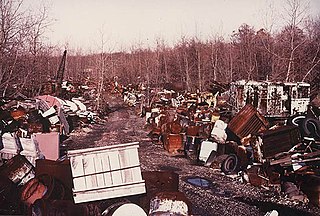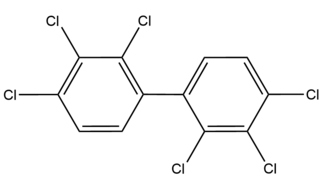
Polychlorinated biphenyls (PCBs) are highly carcinogenic chemical compounds, formerly used in industrial and consumer products, whose production was banned in the United States by the Toxic Substances Control Act in 1976 and internationally by the Stockholm Convention on Persistent Organic Pollutants in 2001.
Polychlorinated dibenzodioxins (PCDDs), or simply dioxins, are a group of long-lived polyhalogenated organic compounds that are primarily anthropogenic, and contribute toxic, persistent organic pollution in the environment.

Green Springs is a village in Sandusky and Seneca counties in the U.S. state of Ohio. The population was 1,233 at the 2020 census.

Toxic waste is any unwanted material in all forms that can cause harm. Mostly generated by industry, consumer products like televisions, computers, and phones contain toxic chemicals that can pollute the air and contaminate soil and water. Disposing of such waste is a major public health issue.
Polybrominated diphenyl ethers or PBDEs, are a class of organobromine compounds that are used as flame retardants. Like other brominated flame retardants, PBDEs have been used in a wide array of products, including building materials, electronics, furnishings, motor vehicles, airplanes, plastics, polyurethane foams, and textiles. They are structurally akin to polychlorinated diphenyl ethers (PCDEs), polychlorinated biphenyls (PCBs) and other polyhalogenated compounds, consisting of two halogenated aromatic rings. PBDEs are classified according to the average number of bromine atoms in the molecule. The health hazards of these chemicals have attracted increasing scrutiny, and they have been shown to reduce fertility in humans at levels found in households. Because of their toxicity and persistence, the industrial production of some PBDEs is restricted under the Stockholm Convention, a treaty to control and phase out major persistent organic pollutants (POPs).

Santa Monica–Malibu Unified School District (SMMUSD) is a school district located in Santa Monica, California. The district serves the cities of Santa Monica and Malibu. It has ten elementary schools, two middle schools, three high schools, an adult high school, and an alternative school.

This is a complete list of polychlorinated biphenyl (PCB) congeners.

Polychlorinated dibenzofurans (PCDFs) are a family of organic compounds with one or several of the hydrogens in the dibenzofuran structure replaced by chlorines. For example, 2,3,7,8-tetrachlorodibenzofuran (TCDF) has chlorine atoms substituted for each of the hydrogens on the number 2, 3, 7, and 8 carbons. Polychlorinated dibenzofurans with chlorines at least in positions 2,3,7 and 8 are much more toxic than the parent compound dibenzofurane, with properties and chemical structures similar to polychlorinated dibenzodioxins. These groups together are often inaccurately called dioxins. They are known developmental toxicants, and suspected human carcinogens. PCDFs tend to co-occur with polychlorinated dibenzodioxins (PCDDs). PCDFs can be formed by pyrolysis or incineration at temperatures below 1200 °C of chlorine containing products, such as PVC, PCBs, and other organochlorides, or of non-chlorine containing products in the presence of chlorine donors. Dibenzofurans are known persistent organic pollutants (POP), classified among the dirty dozen in the Stockholm Convention on Persistent Organic Pollutants.
The Montrose Chemical Corporation of California was a chemical corporation that was the largest producer of the insecticide DDT in the United States from 1947 until it stopped production in 1982. Its improper disposal of chemical waste from DDT production resulted in serious environmental damage to the Pacific Ocean near Los Angeles, and its former main plant in Harbor Gateway South area of Los Angeles near Torrance, California has been designated as a Superfund site by the United States Environmental Protection Agency.
In 1990, the Allied Paper, Inc./Portage Creek/Kalamazoo River in southwestern Michigan was declared by the Environmental Protection Agency (EPA) to be a Superfund site – in other words, an abandoned industrial site containing significant amounts of toxic waste. The EPA and companies responsible for the waste in this area, which includes a three-mile section of Portage Creek as well as part of the Kalamazoo River, into which it flows, are currently involved in an effort to reduce the amount of toxic waste at the site, which is contaminated by PCBs from paper mills and other factories.

The Valley of the Drums is a 23-acre toxic waste site near Brooks in northern Bullitt County, Kentucky, near Louisville, named after the waste-containing drums strewn across the area. After it had been collecting waste since the 1960s, the United States Environmental Protection Agency (EPA) analyzed the property and creek in 1979, finding high levels of heavy metals, polychlorinated biphenyls, and some 140 other chemical substances. It is known as one of the primary motivations for the passage of the Comprehensive Environmental Response, Compensation, and Liability Act, or Superfund Act of 1980. While the widely publicized Love Canal disaster is often credited as the reason the Superfund law was passed, Love Canal activist Lois Gibbs has said that Love Canal looked like a suburban community, while "Valley of the Drums became the visualization of the problem." Officially, cleanup began at the site in 1983 and ended in 1990, though later problems have been reported and investigated.

The Kettleman Hills Hazardous Waste Facility is a large hazardous waste and municipal solid waste disposal facility, operated by Waste Management, Inc. The landfill is located at 35.9624°N 120.0102°W, 3.5 mi (5.6 km) southwest of Kettleman City on State Route 41 in the western San Joaquin Valley, Kings County, California.
Brofiscin Quarry, Groes Faen is a disused limestone quarry in Groes-faen, near Llantrisant in South Wales. It was used for about seven years for the dumping of toxic waste including polychlorinated biphenyls (PCBs) and was capped in 2011. Some 72 000m3 / 80 000 tonnes of material was dumped here. Prior to its remediation, The Guardian described the site as "one of the most contaminated places in Britain." The level of pollution is such that it featured in an international conference discussing remediation of contaminated land. These events were described by The Ecologist magazine as "one of the biggest environmental crimes to have occurred in the UK". and the key witness at an Environmental Agency inquiry on 2006 ended up needing to live under police protection. The company using this disposal site also used the nearby Maendy Quarry.
The Titan Tire Corporation is an American tire corporation formed in 1993 by Maurice M. Taylor Jr., then owner of Titan Wheel, purchased the Dyneer Corporation, manufacturer various off-road tires. Titan is one of the largest manufacturer of off-road tires in North America. It continued expanding its product offering and reach by purchasing the off-road tire assets of Pirelli Armstrong Tire Corporation in 1994. In 1997, Titan International split Titan Tire Corporation into subsidiary of(NYSE: TWI).

The Krejci Dump was a privately owned dump occupying 47 acres (19 ha) on several sites along Hines Hill Road near Boston Heights, Summit County, Ohio. After the area was converted into part of the then-Cuyahoga Valley National Recreation Area, the National Park Service discovered that the property, part of one of the most-heavily used parks in the country, was also one of the most contaminated sites in the United States Environmental Protection Agency's Region V. The dump subsequently became a Superfund cleanup site.
The Dewey Loeffel Landfill is an EPA superfund site located in Rensselaer County, New York. In the 1950s and 1960s, several companies including General Electric, Bendix Corporation and Schenectady Chemicals used the site as a disposal facility for more than 46,000 tons of industrial hazardous wastes, including solvents, waste oils, polychlorinated biphenyls (PCBs), scrap materials, sludges and solids. Some hazardous substances, including volatile organic compounds (VOCs) and PCBs, have migrated from the facility to underlying aquifers and downstream surface water bodies, resulting in contamination of groundwater, surface water, sediments and several species of fish. There is currently a ban on fish consumption in Nassau Lake and the impacted tributaries. Site investigations are underway to determine the nature and extent of the contamination and inform the development of permanent cleanup options for the site.
Emmell's Septic Landfill (ESL) is located at 128 Zurich Ave, Galloway Township, New Jersey and takes up about 38 acres of space. The landfill was in operation from 1967 until 1979. ESL disposed of liquid and solid waste including many chemicals such as volatile organic compounds (VOCs), Polychlorinated Biphenyls (PCBs), Trichloroethene and Vinyl chloride which all had their own effect on the environment and community. These chemicals affected the groundwater required millions of dollars to reconstruct the groundwater pathways and provide clean water to residents. The landfill holds a Hazardous Ranking Score of a 50/100, qualifying for the Superfund National Priority List. In August 1999, the state acknowledged the site's contamination and held town meetings and provided research upon the site such as groundwater samples. In July 1997, a sitewide investigation was called upon by the United States Environmental Protection Agency. In total the clean up was estimated to cost $5 million to fund this superfund site, and a grant of $3.9 million was given by the Federal Government under the Recovery Act Funding (Previti). Today, the project is still ongoing however, greatly improved since the landfill was discovered.
The Diamond Head Oil Refinery is a former oil reprocessing facility located in Kearny, New Jersey, United States, that was designated as a Superfund site by the Environmental Protection Agency (EPA). It opened up in 1946, but then stopped production in 1979 and has been inactive since then. The refinery was shut down in 1980 and the EPA designated it as a Superfund site in 1991 due to the discovery of toxic chemicals in the soil and the surface water. This created a dangerous work environment for the workers at the facility. The EPA proposed a clean up plan for the site, but it has yet to take effect. So far, the Diamond Head site is still in the process of being cleaned up. Although cleanup plans were discussed and finalized, the future of the Diamond Head Oil Refinery and its cleanup state is unknown.
Larry W. Robertson is an American chemist, microbiologist and toxicologist. He is professor at the University of Iowa, Department of Occupational and Environmental Health, known for his work on toxicology of POPs and PCBs, which are important environmental pollutants.

2,2',3,3',4,4'-Hexachlorobiphenyl is an organic chemical and belongs to a group of compounds called polychlorinated biphenyls. This group of organic compounds was used in transformers as dielectric fluids, until production was banned in 1979. While only being a part of this mixture, it is sometimes referred to as Aroclor 1260.









